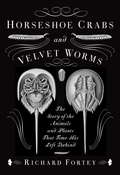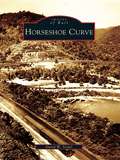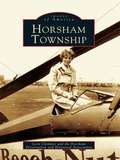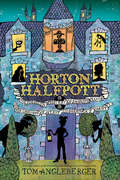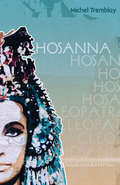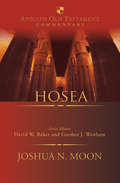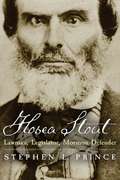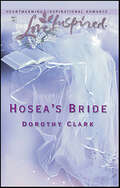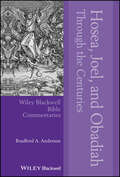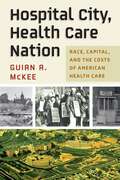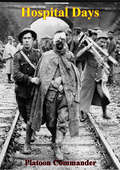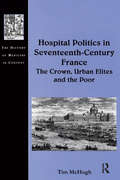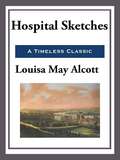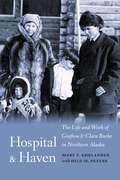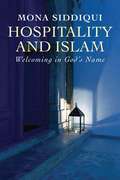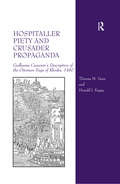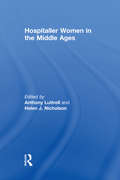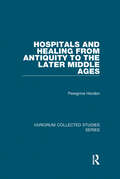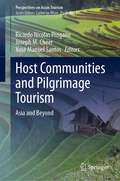- Table View
- List View
Horseshoe Crabs and Velvet Worms
by Richard ForteyFrom one of the world's leading natural scientists and the acclaimed author of Trilobite!, Life: A Natural History of Four Billion Years of Life on Earth and Dry Storeroom No. 1 comes a fascinating chronicle of life's history told not through the fossil record but through the stories of organisms that have survived, almost unchanged, throughout time. Evolution, it seems, has not completely obliterated its tracks as more advanced organisms have evolved; the history of life on earth is far older--and odder--than many of us realize. Scattered across the globe, these remarkable plants and animals continue to mark seminal events in geological time. From a moonlit beach in Delaware, where the hardy horseshoe crab shuffles its way to a frenzy of mass mating just as it did 450 million years ago, to the dense rainforests of New Zealand, where the elusive, unprepossessing velvet worm has burrowed deep into rotting timber since before the breakup of the ancient supercontinent, to a stretch of Australian coastline with stromatolite formations that bear witness to the Precambrian dawn, the existence of these survivors offers us a tantalizing glimpse of pivotal points in evolutionary history. These are not "living fossils" but rather a handful of tenacious creatures of days long gone. Written in buoyant, sparkling prose, Horseshoe Crabs and Velvet Worms is a marvelously captivating exploration of the world's old-timers combining the very best of science writing with an explorer's sense of adventure and wonder.
Horseshoe Curve
by David W. SeidelThe Horseshoe Curve is known worldwide as an engineering achievement by the Pennsylvania Railroad. This landmark, located just west of Altoona, opened to traffic on February 15, 1854, and it enabled a railroad line to climb the Allegheny Mountains and the eastern continental divide. The Horseshoe Curve's construction impacted railroad design and development for mountainous terrain everywhere, enabling access to coal and other raw materials essential for the industrial age. J. Edgar Thomson, chief engineer of the Pennsylvania Railroad, is widely recognized for his engineering and design of the Horseshoe Curve, a concept never utilized previously. Today the curve is still in use and sees approximately 70 trains daily. Through vintage photographs, Horseshoe Curve chronicles how this marvel remains one of the vital transportation arteries linking the east and west coasts of the United States.
Horsham Township
by Horsham Preservation and Historical Association Leon ClemmerHorsham Township began as a farming and residential community. Today, the Willow Grove Naval Air Station is Horsham's largest employer and its most recognized feature. The predecessor of the air station was the Pitcairn Airfield. Here, Harold Pitcairn built the Mailwing airplane, delivered airmail along the East Coast, formed Eastern Air Lines, developed the Autogiro, and entertained celebrities such as Charles Lindbergh and Amelia Earhart. Photographs in Horsham Township show the Quaker meetinghouse, which is the oldest religious building in Horsham and is still in continuous use; the highways that served the township farmers, such as Limekiln Pike, York Road, and Easton Road; and the trolley cars from Doylestown to Willow Grove that connected the township to Philadelphia.
Horton Halfpott: Or, The Fiendish Mystery of Smugwick Manor; or, The Loosening of M'Lady Luggertuck's Corset
by Tom AnglebergerA servant boy becomes an unlikely hero when a thief strikes in this humorous historical mystery by the author of The Strange Case of Origami Yoda. There are so many exciting things in this book—a Stolen Diamond, snooping stable boys, a famous detective, love, pickle éclairs—that it really does seem a shame to begin with ladies&’ underwear . . . It all starts when M&’Lady Luggertuck loosens her corset. As a result of &“the Loosening,&” all the strict rules around Smugwick Manor are abandoned. Shelves go undusted! Cake is eaten! Lunch is lukewarm! Then, when the precious family heirloom, the Luggertuck Lump (quite literally a lump), goes missing, the Luggertucks search for someone to blame. Could the thief really be Horton Halfpott, the good-natured but lowly kitchen boy who can&’t tell a lie? A colorful and hilarious cast comes together in this entertaining mystery, Tom Angleberger&’s loopiest novel yet!Praise for Horton Halfpott &“A positively gleeful historical mystery farce. . . . A satirical homage to Dickens by way of Pratchett and Snicket. Short chapters, a fast pace and plenty of linguistic and slapstistic humor will have young readers hoping that a sequel is planned. The scribbly pen-and-ink chapter-heading cartoon illustrations are just icing on the cake—or pickle éclair. A romp from start to finish.&” —Kirkus Reviews &“Angleberger delivers many spoonfuls of sugar alongside the moral of this Victorian fable.&” —Shelf-Awareness &“Readers are in for a treat.&” —Publishers Weekly
Hosanna
by Michel Tremblay Bill Glassco John Van BurekIn Michel Tremblay's classic play about identity in crisis, Claude leaves the conformity of small-town Quebec to realize a new life and a new persona among the drag queens and prostitutes of Montreal's seedy "Main" - the boulevard that marks the division of the city's anglophone and francophone neighbourhoods.Claude's illusions about himself are shattered when, painstakingly remade as his idol Elizabeth Taylor inCleopatra, he arrives at a costume party themed on "great women of history" and is mocked for his glamorous aspirations. Written during the social and political tumult of Quebec's Quiet Revolution, Tremblay's political allegory about the authenticity of self resonates ever more so today.
Hosanna
by Michel TremblayThird Edition In Michel Tremblay's classic play about identity in crisis, Claude leaves the conformity of small-town Quebec to realize a new life and a new persona among the drag queens and prostitutes of Montreal's seedy "Main" - the boulevard that marks the division of the city's anglophone and francophone neighbourhoods. Claude's illusions about himself are shattered when, painstakingly remade as his idol Elizabeth Taylor in Cleopatra, he arrives at a costume party themed on "great women of history" and is mocked for his glamorous aspirations. Written during the social and political tumult of Quebec's Quiet Revolution, Tremblay's political allegory about the authenticity of self resonates ever more so today. Cast of 2 men. Translated by John Van Burek & Bill Glassco
Hosea (Apollos Old Testament Commentary Series)
by Joshua N. MoonThe prophet Hosea lived through the tumultuous final decades of the Northern Kingdom of Israel. The Assyrian invasion culminated in the destruction of Samaria, the end of the Northern Kingdom, and the exile of many of its people. Hosea called the people to faith in God through warnings of judgment and promises of hope. He exposed the people's infidelity as they turned to other nations, to their own counsels or to other gods for their life and prosperity. Such turning to others for what God alone could give them was, using Hosea's most famous metaphor, "whoring." As God's people, they needed to reckon with "their" God, who had showered them with care and grace. For Hosea, it was their refusal to "return" to their Lord that brought God's judgment upon them in the form of the Assyrian invasion. In this Apollos Old Testament Commentary, Joshua Moon sets the prophecies of Hosea in the context of the eighth century BC. The concern of his commentary is the importance of reading Hosea as Christian scripture, in which we are meant to hear God's own voice as he calls his people to himself. Moon demonstrates the continuing importance of hearing God's words through Hosea, situating the reading of each section within larger biblical and theological concerns.
Hosea Stout: Lawman, Legislator, Mormon Defender
by Stephen L. PrinceHosea Stout witnessed and influenced many of the major civil and political events over fifty years of LDS history, but until the publication of his diaries, he was a relatively obscure figure to historians. Hosea Stout: Lawman, Legislator, Mormon Defender is the first-ever biography of this devoted follower who played a significant role in Mormon and Utah history. Stout joined the Mormons in Missouri in 1838 and followed them to Nauvoo, where he rose quickly to become a top leader in the Nauvoo Legion and chief of police, a position he also held at Winter Quarters. He became the first attorney general for the Territory of Utah, was elected to the Utah Territorial Legislature, and served as regent for the University of Deseret (which later became the University of Utah) and as judge advocate of the Nauvoo Legion in Utah. In 1862, Stout was appointed US attorney for the Territory of Utah by President Abraham Lincoln. In 1867, he became city attorney of Salt Lake City, and he was elected to the Utah House of Representatives in 1881. But Stout’s history also had its troubled moments. Known as a violent man and aggressive enforcer, he was often at the center of controversy during his days on the police force and was accused of having a connection with deaths in Nauvoo and Utah. Ultimately, however, none of these allegations ever found traction, and the leaders of the LDS community, especially Brigham Young, saw to it that Stout was promoted to roles of increasing responsibility throughout his life. When he died in 1889, Hosea Stout left a complicated legacy of service to his state, his church, and the members of his faith community. The University Press of Colorado gratefully acknowledges the generous support of the Charles Redd Center for Western Studies at Brigham Young University toward the publication of this book.
Hosea's Bride
by Dorothy ClarkForced into prostitution by her stepfather, Angela Warren found salvation one dark, terrifying night in Crossroads Church. The words of a handsome visiting preacher and the strength she found in the Lord led her to a new life in Harmony, Colorado.But Angela’s hard-won happiness was threatened when her church appointed a new pastor, Hosea Stevens—the very preacher who’d saved her years ago. Angela tried to avoid him, lest he recognize her, but Hosea persisted in knowing her better. Panicked by his romantic interest—and her own feelings—Angela fled, but Hosea pursued her. Could he bring her back to his church…as his bride?
Hosea, Joel, and Obadiah Through the Centuries (Wiley Blackwell Bible Commentaries)
by Bradford A. AndersonHosea, Joel, and Obadiah Through the Centuries The first book devoted solely to the reception history of Hosea, Joel, and Obadiah How have readers through the centuries understood the prophet Hosea’s marriage to an unfaithful woman? Does the prophet Joel really speak about a locust invasion, or is he referring to invading armies? How should we understand the harsh rhetoric that Obadiah uses about Judah’s neighbor Edom? In Hosea, Joel, and Obadiah Through the Centuries, Bradford A. Anderson provides historical context for these prophetic texts and traditions while offering original insights into their interpretation, use, and impact. Chapter-by-chapter commentary examines the use of these texts in different religious communities, surveys various commentaries and interpretive traditions, and addresses the social and cultural employment of these prophetic works in literature, music, the visual arts, and more. Each prophetic text is introduced by a chapter containing a brief history of interpretation and discussion of key historical, literary issues, theological, thematic, and rhetorical issues, as well as the religious, social, and cultural reception of the prophet and the book. Throughout the text, recurring “conversation partners” high-light important and interesting trajectories in the afterlives of the prophetic books. Encompassing Christian, Jewish, and modern critical reception, Hosea, Joel, and Obadiah Through the Centuries is an excellent textbook for advanced undergraduate and postgraduate students working on these prophetic works, and a must-have resource for scholars, clergy, and religious leaders interested in how the prophets have been employed over the millennia.
Hosni Mubarak and the Future of Democracy in Egypt
by Alaa Al-Din ArafatThe Egyptian revolution of 2011 captivated the world and served as the focal point of the regional uprisings that have collectively come to be known as the Arab Spring. Even now the world waits to see whether the country's elections will aid the progress of liberal democracy or resurgent Islamism. In this essential study, Egyptian scholar Alaa Al-Din Arafat provides a comprehensive look at the political, diplomatic, religious, and socioeconomic factors that were at play in the time leading up to the protests that led to the ouster of Hosni Mubarak. This edition includes a new foreword that reflects on the developments of the last year, providing valuable new context and exploring possible future outcomes.
Hospital Care and the British Standing Army, 1660–1714 (The History of Medicine in Context)
by Eric Gruber ArniAt the Restoration of the Monarchy in 1660, amongst the first acts of Charles II's government was the abolition of the New Model Army and the sweeping away of the legislation and institutions that had supported it, including most of the medical provisions provided by the republican regime. Nevertheless, a small rump of the Commonwealth forces was retained to form a royal standing army, which rapidly expanded over the next sixty years to become a formidable fighting force. Inevitably, as this force grew, the new government was compelled to provide medical care for its soldiers and ex-servicemen. Taking a broadly chronological approach, this book explores the nature and the quality of medical, nursing and welfare facilities provided in hospitals for soldiers during the formative years of the British standing army between 1660 and 1714. It shows how, over the course of latter part of the seventeenth century, the British army adapted and developed its facilities in line with new advances in science, medicine and military theory. Increased involvement in continental wars and contact with European armies provided inspiration for the founding of the well-known Royal Hospitals at Chelsea and Kilmainham, based on Louis XIV's Hôtel des Invalides. The work also provides an in-depth examination of the work of the hitherto sparsely documented field hospitals that provided acute casualty care to troops during the reigns of James II, William III and Queen Anne. Following on from his ground-breaking study of medical care during the English Civil Wars (Justice to the Maimed Soldier), Eric Gruber von Arni in this study shows how the British army of the Restoration period struggled to develop systems and institutions that could cope with the increasing scale of contemporary warfare. Through extensive archival research and a thorough understanding of military medical requirements, a lucid account is provided that will be of interest not only to military and medical historians, but also anyone interested in the development of early modern institutions and organisations.
Hospital City, Health Care Nation: Race, Capital, and the Costs of American Health Care (Politics and Culture in Modern America)
by Guian A. McKeeHospital City, Health Care Nation recasts the story of the U.S. health care system by emphasizing its economic, social, and medical importance in American communities. Focusing on urban hospitals and academic medical centers, the book argues that the country’s high level of health care spending has allowed such institutions to become vital, if often problematic, economic anchors for communities. Yet that spending has also constrained possibilities for comprehensive health care reform over many decades, even after the passage of the Affordable Care Act in 2010. At the same time, the role of hospitals in urban renewal, in community health provision, and as employers of low-wage workers has contributed directly to racial health disparities.Guian A. McKee explores these issues through a detailed historical case study of Baltimore’s Johns Hopkins Hospital while also tracing their connections across governmental scales—local, state, and federal. He shows that health care spending and its consequences, rather than insurance coverage alone, are core issues in the decades-long struggle over the American health care system. In particular, Hospital City, Health Care Nation points to the increased role of financial capital after the 1960s in shaping not only hospital growth but also the underlying character of these vital institutions. The book shows how hospitals’ quest for capital has interacted with structural racism and inequality to shape and constrain the U.S. health care system. Building on this reassessment of the hospital system, its politics, and its financing, Hospital City, Health Care Nation offers ideas for the next steps in health care reform.
Hospital Days
by Arthur F. H. MillsOriginally published under the pseudonym "Platoon Commander" these excellent memoirs were written by the noted novelist Arthur F. H. Mills after his service in the British Expeditionary Force in 1914-1915. Following on from Mill's service in France, he describes his days recuperating from the debilitating wounds he received at La Bassée. His first stop is a field hospital behind the front lines where his leg wound was tended to and a bullet removed; when he was able he was sent on to England. His experiences in the officer's wards of both the army and private hospitals are at once grim and humorous, absent is the disillusionment noted in many memoirs written well after the war.
Hospital Politics in Seventeenth-Century France: The Crown, Urban Elites and the Poor (The\history Of Medicine In Context Ser.)
by Tim McHughThe seventeenth century witnessed profound reforms in the way French cities administered poor relief and charitable health care. New hospitals were built to confine the able bodied and existing hospitals sheltering the sick poor contracted new medical staff and shifted their focus towards offering more medical services. Whilst these moves have often been regarded as a coherent state led policy, recent scholarship has begun to question this assumption, and pick-up on more localised concerns, and resistance to centrally imposed policies. This book engages with these concerns, to investigate the links between charitable health care, poor relief, religion, national politics and urban social order in seventeenth-century France. In so doing it revises our understanding of the roles played in these issues by the crown and social elites, arguing that central government's social policy was conservative and largely reactive to pressure from local elites. It suggests that Louis XIV's policy regarding the reform of poor relief and the creation of General Hospitals in each town and city, as enshrined in the edict of 1662, was largely driven by the religious concerns of the kingdom's devout and the financial fears of the Parisian elites that their city hospitals were overburdened. Only after the Sun King's reign did central government begin to take a proactive role in administering poor relief and health care, utilizing urban charitable institutions to further its own political goals. By reintegrating the social aspirations of urban elites into the history of French poor relief, this book shows how the key role they played in the reform of hospitals, inspired by a mix of religious, economic and social motivations. It concludes that the state could be a reluctant participant in reform, until pressured into action by assisting elite groups pursuing their own goals.
Hospital Sketches
by Louisa May AlcottHospital Sketches is a set of sketches based on letters sent by Louisa May Alcott during the six weeks she spent as a nurse for the Union Army in Georgetown.
Hospital and Haven: The Life and Work of Grafton and Clara Burke in Northern Alaska
by Mary F. Ehrlander Hild M. PetersHospital and Haven tells the story of an Episcopal missionary couple who lived their entire married life, from 1910 to 1938, among the Gwich&’in peoples of northern Alaska, devoting themselves to the peoples&’ physical, social, and spiritual well-being. The era was marked by great social disruption within Alaska Native communities and high disease and death rates, owing to the influx of non-Natives in the region, inadequate sanitation and hygiene, minimal law enforcement, and insufficient government funding for Alaska Native health care. Hospital and Haven reveals the sometimes contentious yet promising relationship between missionaries, Alaska Natives, other migrants, and Progressive Era medicine. St. Stephen&’s Mission stood at the center of community life and formed a bulwark against the forces that threatened the Native peoples&’ lifeways and lives. Dr. Grafton (Happy or Hap) Burke directed the Hudson Stuck Memorial Hospital, the only hospital to serve Alaska Natives within a several-hundred-mile radius. Clara Burke focused on orphaned, needy, and convalescing children, raising hundreds in St. Stephen&’s Mission Home. The Gwich&’in in turn embraced and engaged in the church and hospital work, making them community institutions. Bishop Peter Trimble Rowe came to recognize the hospital and orphanage work at Fort Yukon as the church&’s most important work in Alaska.
Hospitality and Islam
by Mona SiddiquiConsidering its prominent role in many faith traditions, surprisingly little has been written about hospitality within the context of religion, particularly Islam. In her new book, Mona Siddiqui, a well-known media commentator, makes the first major contribution to the understanding of hospitality both within Islam and beyond. She explores and compares teachings within the various Muslim traditions over the centuries, while also drawing on materials as diverse as Islamic belles lettres, Christian reflections on almsgiving and charity, and Islamic and Western feminist writings on gender issues. Applying a more theological approach to the idea of mercy as a fundamental basis for human relationships, this book will appeal to a wide audience, particularly readers interested in Islam, ethics, and religious studies.
Hospitaller Piety and Crusader Propaganda: Guillaume Caoursin's Description of the Ottoman Siege of Rhodes, 1480
by Theresa M. Vann Donald J. KagayGuillaume Caoursin, the Vice-chancellor of the Order of the Hospital, wrote the Obsidionis Rhodiae urbis descriptio (Description of the Siege of Rhodes) as the official record of the Ottoman siege of the Knights in Rhodes in 1480. The Descriptio was the first authorized account of the Order’s activities to appear in printed form, and it became one of the best sellers of the 15th century. The publication of the Descriptio not only fed Western Europe’s hunger for news about an important Christian victory in the ongoing war with the Turks, it also served to shape public perceptions of the Hospitallers. Caoursin wrote in a humanistic style, sacrificing military terminology to appeal to an educated audience; within a few years, however, his Latin text became the basis for vernacular versions, which also circulated widely. Modern historians recognize the contributions that the Ottoman siege of Rhodes in 1480 made in the development of military technology, particularly the science of fortifications. This book is the first complete modern Latin edition with an English translation of the Descriptio obsidionis Rhodiae. Two other published eyewitness accounts, Pierre D’Aubusson’s Relatio obsidionis Rhodie and Jacomo Curte’s De urbis Rhodiae obsidione a. 1480 a Turcis tentata, also appear in modern Latin edition and English translation. This book also includes John Kay’s Description of the Siege of Rhodes and an English translation of Ademar Dupuis’ Le siège de Rhodes. The lengthy introductory chapters by Theresa Vann place the Ottoman siege of Rhodes in 1480 within the context of Mehmed II’s expansion in the Eastern Mediterranean after he captured Constantinople in 1453. They then examine the development of an official message, or propaganda, as an essential tool for the Hospitallers to raise money in Europe to defend Rhodes, a process that is traced through the chancery’s official communications describing the aftermath of Constantinople and the Ottoman
Hospitaller Piety and Crusader Propaganda: Guillaume Caoursin's Description of the Ottoman Siege of Rhodes, 1480
by Theresa M. Vann Donald J. KagayGuillaume Caoursin, the Vice-chancellor of the Order of the Hospital, wrote the Obsidionis Rhodiae urbis descriptio (Description of the Siege of Rhodes) as the official record of the Ottoman siege of the Knights in Rhodes in 1480. The Descriptio was the first authorized account of the Order’s activities to appear in printed form, and it became one of the best sellers of the 15th century. The publication of the Descriptio not only fed Western Europe’s hunger for news about an important Christian victory in the ongoing war with the Turks, it also served to shape public perceptions of the Hospitallers. Caoursin wrote in a humanistic style, sacrificing military terminology to appeal to an educated audience; within a few years, however, his Latin text became the basis for vernacular versions, which also circulated widely. Modern historians recognize the contributions that the Ottoman siege of Rhodes in 1480 made in the development of military technology, particularly the science of fortifications. This book is the first complete modern Latin edition with an English translation of the Descriptio obsidionis Rhodiae. Two other published eyewitness accounts, Pierre D’Aubusson’s Relatio obsidionis Rhodie and Jacomo Curte’s De urbis Rhodiae obsidione a. 1480 a Turcis tentata, also appear in modern Latin edition and English translation. This book also includes John Kay’s Description of the Siege of Rhodes and an English translation of Ademar Dupuis’ Le siège de Rhodes. The lengthy introductory chapters by Theresa Vann place the Ottoman siege of Rhodes in 1480 within the context of Mehmed II’s expansion in the Eastern Mediterranean after he captured Constantinople in 1453. They then examine the development of an official message, or propaganda, as an essential tool for the Hospitallers to raise money in Europe to defend Rhodes, a process that is traced through the chancery’s official communications describing the aftermath of Constantinople and the Ottoman
Hospitaller Women in the Middle Ages
by Anthony Luttrell Helen J. NicholsonThis volume brings together recent and new research, with several items specially translated into English, on the sisters of the largest and most long-lived of the military-religious orders, the Hospital of St John of Jerusalem. In recent years there has been increasing scholarly interest in women's religious houses during the Middle Ages, with particular focus on the problems which they faced and the social needs which they performed. The military-religious orders have been largely excluded from this interest, partly because it has been assumed that women played little role in religious orders with a predominantly military purpose. Recent research has shown this to be a misconception. Study of the women members of these orders enables scholars to gain a deeper appreciation of the nature of hospitaller and military orders and of the role of women in religious life in general. The papers in this volume explore the roles which the Hospitaller sisters performed within their order; examine the problems of having men and women living within the same or adjoining houses; study relations between the order and the patrons of its women's houses; and consider the career of a prominent Hospitaller woman who became a saint. This volume will be of interest not only to scholars of the military-religious orders and of the Hospital of St John in particular, but also to scholars of monastic history and to those with a concern for women's history during the middle ages.
Hospitallers and Others: Military and Social Encounters (Crusades - Subsidia)
by Christie Majoros Maria Bonet Donato Julia Pavón BenitoThis book features a collection of essays that focus on the Hospitallers’ relations with others through military, social, and political channels within the broader Euro‑Mediterranean region. Centered on Hospitaller settlement and activities in Rhodes and their European priories, this study highlights the various encounters made possible by the far‑reaching and international character of the Order’s activities. In addition to examining Hospitaller encounters and relationships with those outside the Order, this collection also includes essays that explore the internal workings of Hospitaller priories and the Central Convent of the Order during periods of change and expansion, revealing a propensity for continual adaptation and reinvention. Hospitallers and Others: Military and Social Encounters will appeal to scholars and students alike, providing a deeper understanding of the social, military, spiritual, and institutional transformation of the Hospitallers during the medieval period.
Hospitals and Healing from Antiquity to the Later Middle Ages (Variorum Collected Studies)
by Peregrine HordenThe first part of this collection brings together a selection of Peregrine Horden's papers on the history of hospitals and related institutions of welfare provision from their origins in Late Antiquity to their medieval flourishing in Byzantium and the Islamic lands as well as in western Europe. The hospital is seen in a variety of original contexts, from demography and family history to the history of music and the liturgy. The second part turns to the history of healing and medicine, outside the hospital as well as within it. These studies cover a period from Hippocratic times to the Renaissance, but with a particular focus on the Mediterranean region - Byzantine, Middle Eastern and Western - in the Middle Ages.
Host Communities and Pilgrimage Tourism: Asia and Beyond (Perspectives on Asian Tourism)
by Joseph M. Cheer Ricardo Nicolas Progano Xosé Manuel SantosThis book delves into topics on pilgrimage travel and communities from a variety of perspectives through academic research based on the Middle East, Northeast Asia, the Indian subcontinent, and Europe, where sacred sites have become of great importance for both international and domestic tourism. In particular, Europe and Asia possess a high volume of world-renowned pilgrimage sites that are currently being developed as tourism destinations in their respective countries, such as Santiago de Compostela (Spain), Lourdes (France), and Koyasan (Japan). This book includes studies on these two continents that harbor both a great history of pilgrimage tradition, as well as tourism development related to religious travel. The book importantly covers the role of the community in religious tourism, as well as the impact on the locals, which is comparatively an unexplored area. Whilst pilgrimage is seen as an effective tool to revitalize local economies, this book also reveals the different challenges to achieving this goal. Realizing the importance of the interrelationship of community and pilgrimage travel, as well as the lack of studies on it, this book seeks to address this research gap through 14 chapters divided into two parts, ‘Communities and Constestation’ and ‘Pilgrimage Shaping Communities’. To ensure diverse perspectives, case studies from different Eurasian countries, written by authors with expertise in the study of pilgrimage and religious travel, are included. Readers can expect to gain new perspectives by having a deeper comprehension of the ‘community side‘ of pilgrimage travel in Eurasia, and thus an integral understanding of contemporary pilgrimage
